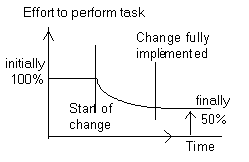 |
 |
 |
 |
 |
 |
 |
 |
 |
Changing to new Shift Patterns |
Staff Scheduling & Staff Rostering Software - Visual Rota
There are many books and articles covering this management topic, but one aspect is not covered, the differing viewpoints of managers implementing changes and staff involved in the change.
 |
Change from the management viewpoint is always beneficial (as long as this change is instigated by them, externally imposed change, such as a takeover or market condition, is not welcomed). It helps management, the manager, the company and ultimately the employee. The graph on the left shows staff initially working at 100% effort or productivity. A change is introduced which brings immediate benefit and when fully implemented, there is a definite improvement. In this example, the graphs shows that it takes half the effort to perform the same task. |
 |
Change is always imposed upon the employees, only rarely is it instigated by them, and their viewpoint on change is entirely different. The staff are working at 100% effort, or productivity, and any change requires more effort from the staff. This could mean working extra hours, training, and a host of changes in the normal routine. When the change is fully implemented, maybe the old job will require less effort, but every employee knows that there will be new work that fills up the spare capacity. There is no net gain to the staff, only more work in having the change. |
 |
The above staff's viewpoint is bad enough, but at the back of their mind is the fear of the change resulting in less staff required to do the work and consequent unemployment. So here, staff have to work harder in order to become unemployed and turkeys do not vote for Christmas! |
|
Proper planning can overcome many problems associated with change management. A clear goal, and a clear series of steps towards that goal are essential. Next, communication is important, tell the employees about the changes, the process by which they will be achieved and all the intermediate steps. If your planning is any good, then communication becomes easy. The plans will include the likely areas of resistance to any changes, so a significant element of the planning should be aimed at minimising resistance, and as soon as new problems(objections) occur, they should be included in the plans. In a recent example where we had been asked to plan a new shift pattern to go from the current 6 days per week, to covering 7 days a week. I noticed that the staff currently had most of their days off as single days, and always Sunday, of course, rather than together. I set up the new roster and we emphasised how the employees could have their days off together during the week, most weeks, instead of only rarely. In a meeting, their spokesperson objected to this arrangement on the grounds that they were so used to having only 1 day off at a time, that they would prefer to keep that arrangement. In reality, it was easy enough to re-arrange the shift pattern to encompass both single days off and days off together and let the employees choose which they preferred. We often set up new staffing rosters, this is a specialist task and it can be almost impossible to set up manually. In fact it can sometimes take days of hard work! We short-cut the process by using our computer programs and our experience and skill. One method of change is to do it in small steps. Ask precisely what needs to be changed and start in small steps in carefully selected areas. Make things better in one area, for both employees and the organization, and you have both a model, you can repeat, and an example to draw on. We often advise a series of staff rosters set up to take advantage of known future activities. For instance, if a planned change will result in fewer staff eventually, we advise setting up a series of staff roster, such that as natural staff turnover occurs, due to promotions, retirements, resignations, departmental moves, etc. then a new staff roster is already prepared with less staff. More alecrmation about Visual Rota
Contact: Alec Jezewski CDT (C-Desk Technology) www.oranalysts.com |